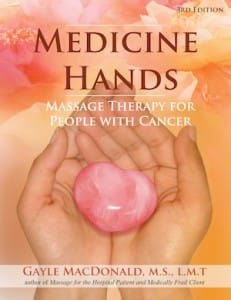Massage Therapy for People with Cancer

Excerpt from: Medicine Hands: Massage Therapy for People with Cancer
by Gayle McDonald

People affected by cancer can have complex health profiles. Organizing their medical history and creating a massage therapy plan is a skill that takes practitioners many years to become proficient at. In order to make the plethora of information manageable, three categories are used to organize it:
• Pressure cautions
• Site considerations
• Positioning adjustments
These three categories provide a simple framework that a therapist can use when collecting their patient’s medical information and planning their session. Extensive knowledge about each cancer and treatment modality is not possible for doctors and nurses, let alone touch therapists. Rather than organizing around the type of cancer, the structure will be formed around the side effects of the treatment or disease.
Pressure Adjustments
General, overall pressure is the first aspect to consider when planning a massage session. It is like the bass notes in a musical composition; they form a foundation on which the other notes rest. There may be areas of the body that need less pressure, or there may be areas that can tolerate a bit more, but the starting place when planning a massage is with the overall general pressure.
The pressure of the massage strokes must match the general energy level of the client in order to create a session that is comfortable. Pressure that is too vigorous can leave people feeling fatigued, nauseated, or in pain. And in the worst-case scenarios, it could cause bruising, bone fractures, or lymphedema.
OMTimes Magazine is one of the leading on-line content providers of positivity, wellness and personal empowerment. OMTimes Magazine - Co-Creating a More Conscious Reality








